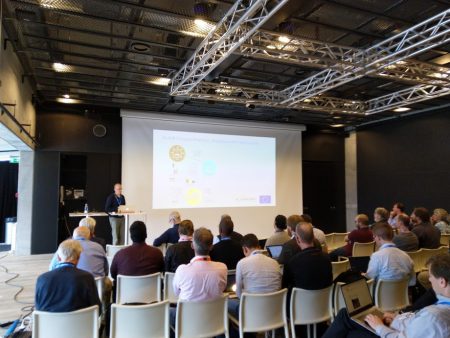Forget Fancy Tools, AI Needs a More Pragmatic Approach to Software
 Huawei’s recent AI portfolio release emphasizes that AI isn’t just a collection of fancy machine learning libraries but is instead a facet of a much larger, living system.
Huawei’s recent AI portfolio release emphasizes that AI isn’t just a collection of fancy machine learning libraries but is instead a facet of a much larger, living system.
GLIF 2018 Held at the Home of Hamlet

The 18th Annual Global LambaGrid Workshop (GLIF 2018) was held on 18-21 September 2018 at the Kulturværftet in Helsingør (Elsinore), Denmark. Kronberg Castle, located next to the venue, was immortalised as Elsinore in the William Shakespeare play Hamlet, but there proved to be nothing rotten with the state of high-bandwidth networking as 50 participants from 19 countries came to hear how these networks are facilitating exascale computing in support of biological, medical, physics, energy production and environmental research, and to discuss the latest infrastructure developments.
This event was organised by myself with support from NORDUnet who hosted the event in conjunction with the 30th NORDUnet Conference (NDN18), and where I also took the opportunity to raise awareness of the MANRS initiative.

The keynote was provided by Steven Newhouse (EBI) who presented the ELIXIR Compute Platform which was being used for analysing life science data. In common with high-energy physics, genomics research produces a lot of data, but this is more complex and variable, requires sequencing and imqging on shorter timescales, and of course has privacy issues. The European Molecular Biology Laboratory is based across six countries and employs over 1,600 people, but also collaborates with thousands of other scientists Continue reading
A Question of Timing


When considering website performance, the term TTFB - time to first byte - crops up regularly. Often we see measurements from cURL and Chrome, and this article will show what timings those tools can produce, including time to first byte, and discuss whether this is the measurement you are really looking for.
Timing with cURL
cURL is an excellent tool for debugging web requests, and it includes the ability to take timing measurements. Let’s take an example website www.zasag.mn (the Mongolian government), and measure how long a request to its home page takes:
First configure the output format for cURL in ~/.curlrc:
$ cat .curlrc
-w "dnslookup: %{time_namelookup} | connect: %{time_connect} | appconnect: %{time_appconnect} | pretransfer: %{time_pretransfer} | starttransfer: %{time_starttransfer} | total: %{time_total} | size: %{size_download}\n"Now connect to the site dropping the output (-o /dev/null) since we’re only interested in the timing:
$ curl -so /dev/null https://www.zasag.mn
dnslookup: 1.510 | connect: 1.757 | appconnect: 2.256 | pretransfer: 2.259 |
starttransfer: 2.506 | total: 3.001 | size: 53107These timings are in seconds. Depending on your version of cURL, you may Continue reading
BGP Labeled Unicast (BGP-LU)
The post BGP Labeled Unicast (BGP-LU) appeared first on Noction.
The Network Automation Paradox: Why People are Key to Its Success
The industry’s inability to move forward with network automation despite its benefits means it’s time to try a new approach. That approach must focus on people to accelerate the pace of automation adoption.
MUST READ: Operational Security Considerations for IPv6 Networks
A team of IPv6 security experts I highly respect (including my good friends Enno Rey, Eric Vyncke and Merike Kaeo) put together a lengthy document describing security considerations for IPv6 networks. The document is a 35-page overview of things you should know about IPv6 security, listing over a hundred relevant RFCs and other references.
No wonder enterprise IPv6 adoption is so slow – we managed to make a total mess.
Sonoff Flashing and steps towards Smart home
This post is no way related to Networking ! 
It’s always my fascination to implement a specific tech towards home automation so as to have more time in hands. The first step towards this was to use a Tp-link smart switch which came with Alexa, now problem with that is that Tplink app was not properly responding to Alexa and TP-Link smart switch in itself was costly.
I wanted something low-cost, something which I can experiment yet be cost effective, After some re-search I came across Sonoff-Basic model.
https://sonoff.itead.cc/en/products/sonoff/sonoff-basic
I integrated with Amazon echo but again there were app issues (default app is ewelink), though it was working fine something was missing, I couldn’t tinker it to my wish
I found then there is a open-source version of a similar firmware called TASMOTA and we have to flash this sonoff with the new firm-ware of Tasmota, I have to tell you here there is every possibility you would brick your device and make it useless in the process.
https://github.com/arendst/Sonoff-Tasmota/wiki/Prerequisite
Everything is so well documented, there is no need to re-iterate things here, but just to show case another successful implementation.
Need-less to say you are playing with AC/DC Continue reading
Mobile Security Still Needs More Work in Most Enterprises
A recent survey on mobile security confirms what most suspect. Most enterprises still have much work to do to bring mobile security up to par, especially for devices that spend most of their time connecting to data and applications on third-party networks.
Comparing Upgrade Strategies with Cumulus Linux
You’ve been running your Cumulus Linux network for a while, and everything has been running perfectly. Cumulus Linux has sliced your bread, you’ve gotten a promotion because your boss can’t believe how successful the project was, and the cost savings being felt by the organization. Your company has even been able to fire the accountant because Cumulus Linux has surprisingly also done your taxes for the coming year, and in general everything is going swimmingly with your open networking.
So what now, is our story over? Well not exactly, enterprise networks have long lifespans. Hyperscalers typically operate on a refresh cycle of 3-5 years. For them, anything over 3/yrs old is considered tech debt. Anything over 5/yrs old is considered a critical fault point. Your typical enterprise network may be around even longer than that. It is very common in this timespan for the needs of the applications to change requiring the network to change too. This often requires support for newer features at some point in the lifecycle of the equipment.
While the scenario above is quite rosey, (Hey – this is our blog after all!) the reasons for wanting to upgrade are many and varied. New features, Continue reading
More Videos By Us

During VMworld 2018, the Packet Pushers team girded themselves with an array of video gear. We conducted a live deployment to validate some ideas we had about producing video. Our starting idea is to asking a single question “What do customers not know about your company/product/technology?” In the end, we did about 30 videos of […]
The post More Videos By Us appeared first on EtherealMind.